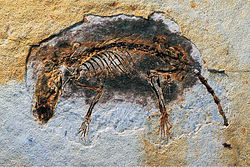Eomaia
|
Eomaia Temporal range: Early Cretaceous, 125 Ma |
|
|---|---|
 |
|
| Fossil specimen CAGS 01−IG−1 | |
| Scientific classification | |
| Kingdom: | Animalia |
| Phylum: | Chordata |
| Class: | Mammalia |
| Clade: | Tribosphenida |
| Genus: |
†Eomaia Ji et al., 2002 |
| Type species | |
|
†Eomaia scansoria Ji et al., 2002 |
|
Eomaia ("dawn mother") is a genus of extinct fossil mammals containing the single species Eomaia scansoria, discovered in rocks that were found in the Yixian Formation, Liaoning Province, China, and dated to the Barremian Age of the Lower Cretaceous about 125 million years ago. The single fossil specimen of this species is 10 centimetres (3.9 in) in length and virtually complete. An estimate of the body weight is between 20–25 grams (0.71–0.88 oz). It is exceptionally well-preserved for a 125-million-year-old specimen. Although the fossil's skull is squashed flat, its teeth, tiny foot bones, cartilages and even its fur are visible.
The Eomaia fossil shows clear traces of hair. However, this is not the earliest clear evidence of hair in the mammalian lineage, as fossils of Volaticotherium, and the docodont Castorocauda, discovered in rocks dated to about 164 million years ago, also have traces of fur.
Eomaia scansoria possessed several features in common with placental mammals that distinguish them from metatherians, the group that includes modern marsupials. These include an enlarged malleolus ("little hammer") at the bottom of the tibia (the larger of the two shin bones), a joint between the first metatarsal bone and the entocuneiform bone in the foot which is offset further back than the joint between the second metatarsal and mesocuneiform bones (in metatherians these joints are level with each other), as well as various features of jaws and teeth.
...
Wikipedia
